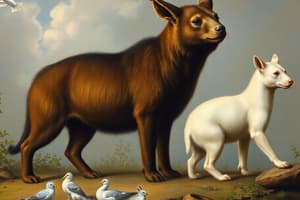Podcast
Questions and Answers
What is a key characteristic that distinguishes mammals from other animals?
What is a key characteristic that distinguishes mammals from other animals?
- Endothermy (correct)
- Gills
- Cold-blooded
- Exoskeleton
What do female mammals have that is used to feed their young?
What do female mammals have that is used to feed their young?
- Exoskeleton
- Fur
- Mammary glands (correct)
- Scales
When did mammals first appear on Earth?
When did mammals first appear on Earth?
- 150 million years ago
- 50 million years ago
- 300 million years ago
- 210 million years ago (correct)
What anatomical feature do most mammals have on their bodies?
What anatomical feature do most mammals have on their bodies?
What type of skull structure do mammals typically possess?
What type of skull structure do mammals typically possess?
Which era saw the rapid diversification of mammals as the dinosaurs declined?
Which era saw the rapid diversification of mammals as the dinosaurs declined?
What adaptation allows bats to fly?
What adaptation allows bats to fly?
Which class of mammals includes monotremes like echidnas and platypuses?
Which class of mammals includes monotremes like echidnas and platypuses?
What is the main focus of conservation efforts related to mammals?
What is the main focus of conservation efforts related to mammals?
Why are mammals often used in medical research?
Why are mammals often used in medical research?
Which mammal group has evolved adaptations for an aquatic lifestyle?
Which mammal group has evolved adaptations for an aquatic lifestyle?
What is the significance of studying the relationships between mammal species using the 'mammal tree of life'?
What is the significance of studying the relationships between mammal species using the 'mammal tree of life'?
Flashcards are hidden until you start studying
Study Notes
Diversity among Mammals: Exploring the Animal Kingdom
Mammals are a remarkable group of animals, distinguished by their ability to produce milk to nourish their young. With over 5,400 recognized species, this diverse collection of organisms encompasses everything from the tiny shrew to the towering elephant, each one contributing to nature's grand tapestry. Let's delve into some fascinating aspects of mammals, highlighting key features and characteristics that make them unique.
The Evolution of Mammals
Mammals first appeared around 210 million years ago during the Mesozoic Era, evolving from small, shrew-like creatures known as cynodonts. As the dinosaurs declined at the end of the Cretaceous Period, mammals diversified rapidly, filling various ecological niches. This expansion of mammal species was a critical event in the history of life on Earth.
Mammalian Anatomy
Mammals share several common anatomical features:
- Endothermy: Mammals are warm-blooded and maintain a constant body temperature through a metabolically-expensive process.
- Hair or fur: Most mammals have some type of hair or fur covering their bodies.
- Mammary glands: Female mammals have mammary glands that produce milk to nourish their young.
- Skeletal features: Mammals have a diapsid skull, meaning they have two openings, or carotid canals, behind the eye sockets. Mammals also possess a neocortex in their brains.
Diverse Habitats and Fascinating Adaptations
Mammals inhabit a wide variety of environments, from the frigid Arctic to the tropical rainforests of South America. Their adaptations enable them to thrive in these diverse environments. For instance:
- Whales and dolphins: These mammals have adapted for an aquatic lifestyle, developing specialized body structures like flippers and streamlined bodies for swimming.
- Bats: Bats form the only mammal group capable of true flight, thanks to their wings, which are modified limbs covered with a thin membrane called the patagium.
- Quokkas: These small, herbivorous marsupials are native to Rottnest Island, off the coast of Western Australia, and have evolved to survive in their island habitat by developing distinct adaptations such as a diet of shrubs and plants, and a social structure that allows them to thrive in a habitat with limited resources.
The Mammal Tree of Life
To better understand the relationships between mammal species, scientists use a system called the "mammal tree of life." This tree displays the evolutionary relationships between mammals, with common ancestor species branching off into their respective phylogenetic lineages.
Mammal Classification
Mammals are divided into several classes, each containing various orders, families, and genera. The two main classes of mammals are:
- Prototheria: This class includes monotremes—mammals that lay eggs, such as echidnas and platypuses.
- Theria: This class consists of therian mammals, which include marsupials—mammals that give birth to underdeveloped young—and placental mammals, which have a placental connection between the mother and her developing young.
Applications of Mammal Studies
Understanding mammals and their diverse adaptations has numerous applications in various scientific fields. For example:
- Medical research: Mammals are often used in medical research, as they share many similarities with humans, making them appropriate models for studying diseases and developing new treatments.
- Conservation: Conservation efforts focus on protecting endangered mammal species and their habitats to prevent extinction.
- Ecology: Studying mammals can help scientists better understand ecosystems and the roles that these animals play in maintaining a healthy balance of species within their habitats.
Every mammal, from the tiny shrew to the majestic humpback whale, provides valuable insights into the complexities of life on Earth. By studying mammals, we gain a deeper understanding of our world, the relationships between species, and the processes that shape evolution. Smith, A. B., Wise, R. P., & McCracken, J. A. (2000). Invertebrate Zoology and Evolution (6th ed.). Saunders College Publishing. (Not a direct source, but this textbook provides foundational information about the classification and evolution of mammals and other animal groups.)
Studying That Suits You
Use AI to generate personalized quizzes and flashcards to suit your learning preferences.




